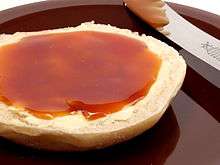Rose hip


The rose hip, also known as rose haw or rose hep, is the fruit of the rose plant, that typically is red-to-orange, but ranges from dark purple to black in some species. Rose hips begin to form after successful pollination of flowers in spring or early summer, and ripen in late summer through autumn.
Propagation
Roses are propagated from hips by removing the achenes that contain the seeds from the hypanthium (the outer coating) and sowing just beneath the surface of the soil. The seeds can take many months to germinate. Most species require chilling (stratification), with some such as Rosa canina only germinating after two winter chill periods have occurred.
Usage

Rose hips are used for herbal teas, jam, jelly, syrup, rose hip soup, beverages, pies, bread, wine, and marmalade. They can also be eaten raw, like a berry, if care is used to avoid the hairs inside the fruit.
A few rose species are sometimes grown for the ornamental value of their hips, such as Rosa moyesii, which has prominent large red bottle-shaped fruits.
Rose hips are commonly used as a herbal tea, often blended with hibiscus, and an oil is also extracted from the seeds. They can also be used to make jam, jelly, marmalade, and rose hip wine. Rose hip soup, "nyponsoppa", is especially popular in Sweden. Rhodomel, a type of mead, is made with rose hips.
Rose hips can be used to make pálinka, the traditional Hungarian fruit brandy popular in Hungary, Romania, and other countries sharing Austro-Hungarian history. Rose hips are also the central ingredient of cockta, the fruity-tasting national soft drink of Slovenia.
The fine hairs found inside rose hips are used as itching powder.[1] Dried rose hips are also sold for primitive crafts and home fragrance purposes.
Nutrients and phytochemicals
Rose hips are particularly high in vitamin C, one of the richest plant sources available. However, RP-HPLC assays of fresh rose hips and several commercially available products revealed a wide range of L-ascorbic acid (vitamin C) content, ranging from 0.03 to 1.3%.[2] Rose hips of some species, especially Rosa canina (dog rose) and R. majalis, have been used as a source of vitamin C.
Rose hips contain the carotenoids beta-carotene, lutein, zeaxanthin and lycopene, which are under basic research for a variety of potential biological roles, such as inhibiting oxidation of low density lipoprotein.[3][4]
A meta-analysis of human studies examining the potential for rose hip extracts to reduce arthritis pain concluded there was a small effect requiring further analysis of safety and efficacy in clinical trials.[5] It is not considered an appropriate treatment for knee osteoarthritis.[6]
See also
References
| Wikimedia Commons has media related to Rose hip. |
- ↑ Albert MR (1998). "Novelty shop "itching powder". Australasian J Dermatology. 39 (3): 188–9. doi:10.1111/j.1440-0960.1998.tb01281.x.
- ↑ Ziegler SJ (1986). "Fast and Selective Assay of l-Ascorbic Acid in Rose Hips by RP-HPLC Coupled with Electrochemical and/or Spectrophotometric Detection". Planta Medica. 52 (5): 383–7. doi:10.1055/s-2007-969192. PMID 17345347.
- ↑ Jacoby FC; Wokes F (1944). "Carotene and lycopene in rose hips and other fruit". Biochem J. 38 (3): 279–82. doi:10.1042/bj0380279. PMC 1258081
 . PMID 16747793.
. PMID 16747793. - ↑ Horváth, G; Molnár, P; Radó-Turcsi, E; Deli, J; Kawase, M; Satoh, K; Tanaka, T; Tani, S; Sakagami, H; Gyémánt, N; Molnár, J (2012). "Carotenoid composition and in vitro pharmacological activity of rose hips" (PDF). Acta Biochimica Polonica. 59 (1): 129–32. PMID 22428123.
- ↑ Christensen, R; Bartels, E. M.; Altman, R. D.; Astrup, A; Bliddal, H (2008). "Does the hip powder of Rosa canina (rosehip) reduce pain in osteoarthritis patients?--a meta-analysis of randomized controlled trials". Osteoarthritis Cartilage. 16 (9): 965–72. doi:10.1016/j.joca.2008.03.001. PMID 18407528.
- ↑ McAlindon, T. E.; Bannuru, R. R.; Sullivan, M. C.; Arden, N. K.; Berenbaum, F; Bierma-Zeinstra, S. M.; Hawker, G. A.; Henrotin, Y; Hunter, D. J.; Kawaguchi, H; Kwoh, K; Lohmander, S; Rannou, F; Roos, E. M.; Underwood, M (2014). "OARSI guidelines for the non-surgical management of knee osteoarthritis". Osteoarthritis and Cartilage. 22 (3): 363–88. doi:10.1016/j.joca.2014.01.003. PMID 24462672.